St Thomas a Beckett’s Church is situated in St Thomas Green, Haverfordwest. The memorial is made of brass, and is fixed onto a marble slab on an interior wall in the Church. Also inside the church is a framed parchment scroll, which commemorates all of the men of the Parish who served. Details of the names on the scroll are to the base of this page.
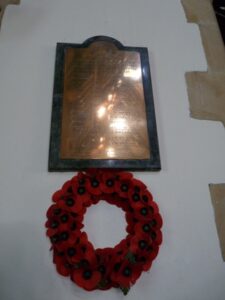
The Great War, 1914-1918
Ernest George Stanley Anderson, Private, 64105, Machine Gun Corps. Ernest was born at Haverfordwest, and resided at 24, Grove Place, St. Thomas Green, Haverfordwest with his Grandmother. He was the nephew of Mrs. Blanche Ethel Owen, of 67, Brynhyfryd Road, Briton Ferry, Glamorgan. He worked as a clerk prior to enlisting at Haverfordwest on 10 December 1915 into the Welsh Regiment, with the Regimental Number 6212. On 11 February 1917 he arrived in France, and joined the 32nd Company, Machine Gun Corps. During March 1918 Ernest was transferred to the 11th Battalion, Machine Gun Corps, which was attached to the 11th (Northern) Division. The Division didn’t see any major fighting for some months after the Passchendaele Offensive had been closed down, until fighting in August 1918 at the Battle of the Scarpe, during the Second Battles of Arras. The Allies were now in the ascendency, and began the great push that was to force the Germans into losing the war, and the Division fought at the Battle of Drocourt-Queant, the Battle of the Canal du Nord, then at the Battle of Cambrai at the beginning of October. From here they took part in the Pursuit to the Selle, and it is around this stage of the offensive that Ernest was killed on 4 October 1918. He was 24 years old, and is buried in Chapel Corner Cemetery, Sauchy-Lestree, France.
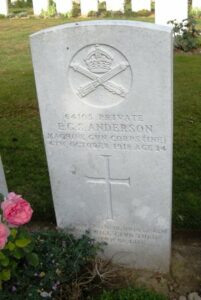
George Alfred Baillieux, Private, 389, Welsh Regiment. George was the son of Lambert Francis and Eliza Anne Baillieux, of 3, St. Mary’s Street, Haverfordwest. He enlisted at Haverfordwest into the 1/4th Battalion, Welsh Regiment. The Battalion was formed in Carmarthen in August 1914 and joined 159 Brigade, 53rd (Welsh) Division. The Division moved to the Mediterranean, sailing from Devonport in July 1915, arriving at Mudros by 5 August 1915. From here they moved to Gallipoli, landing on 8 August 1915. Here the division was plunged into desperate fighting, spending the next few days in isolated pockets, fighting against a Turkish counter-attack. The Division remained here throughout the coming months, and suffered severe losses here. George was taken ill on Gallipoli, and evacuated by Hospital Ship to the Military Hospital at Lemnos, where he sadly died on 29 September 1915. He was just 18 years old, and is buried in Portianos Military Cemetery, Lemnos, Greece.
David Davies, Private, 8828, Welsh Regiment. David was born at Haverfordwest, and enlisted there into the 2nd Battalion, Welsh Regiment several years prior to the war. The Battalion was attached to 3 Brigade, 1st Division, which had been one of the first to arrive in France, fighting at the Battle of Mons, and taking part in the retreat to the Marne, where the Germans were stopped. They then fought at the Aisne, and at Chivy, before being moved North to Ypres. David was wounded during this time, and was evacuated to the Base Hospital at Boulogne for treatment, but he sadly died of wounds there on 27 October 1914. He is buried in Boulogne Eastern Cemetery, France.
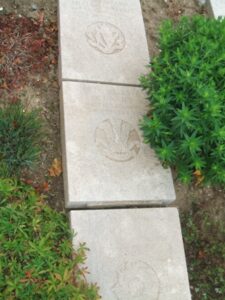
Thomas Henry Davies, Smith Gunner, 1938, Royal Garrison Artillery. Thomas was the son of William and Margaret Davies, of 45, Merlin’s Hill, Haverfordwest. He married Husband of Sarah John on 5 October 1905 and the couple moved in with Thomas’s parents, where they had four children. Thomas was a Carriage Smith, and also a reservist, and on 5 September 1914 had rejoined the Royal Garrison Artillery. He was posted to the RGA Depot before joining the 5th Siege Battery in France on 23 December 1914. On 15 May 1915 he was hospitalised after taking ill in France, and returned to England where he was found to have contracted tuberculosis. On 7 February 1916 he was discharged as medically unfit, and returned to Haverfordwest. He died on 29 August 1917 aged 43, and was buried in St. Thomas’ Cemetery, Haverfordwest. Thomas was accepted for commemoration by the CWGC on Thursday 5 March 2015, and has recently had a new CWGC headstone erected to commemorate him.
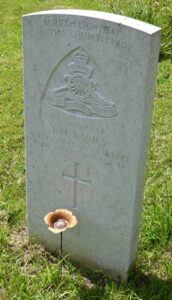
William Davies, Driver, W/5254, Royal Field Artillery. William was born at Haverfordwest, and enlisted there into the Royal Field Artillery. He served with “C” Battery, 122nd Brigade, which was attached to the 38th (Welsh) Division. The Division had landed in France during December 1915 and had spent their first winter in the trenches near Armentieres. In June they marched south to the Somme, where they famously captured Mametz Wood. The Division suffered terrible casualties at Mametz, and were taken out of the line, and moved to Ypres to rebuild. Here they fought at the Battle of Pilckem Ridge, and the Battle of Langemarck. William was wounded at sometime during these Battles, and died of his wounds at a Casualty Clearing Station on 31 August 1917. He is buried in Dozinghem Military Cemetery, Belgium.
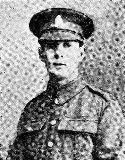
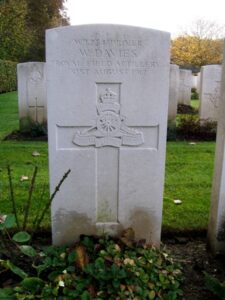
Edgar Gordon Edwards, Private, 5352, Welsh Regiment. Edgar was the son of William and Martha Edwards, of 101, Albert Town, Haverfordwest. He enlisted at Carmarthen into the 1/4th Battalion, Welsh Regiment, which was attached to 159 Brigade, 53rd (Welsh) Division. The 53rd Division moved to the Mediterranean, sailing from Devonport in July 1915 arriving at Mudros by 5 August 1915. From here they moved to Gallipoli, landing on 8 August 1915. Here they immediately faced the chaotic leadership that was to lead to the ultimate failure of the campaign, and spent the next few days in isolated pockets, fighting against a Turkish counter-attack. Edgar was killed soon after landing, on 10 August 1915, aged 27, during the Battle of Sari Bair (Attack on Scimitar Hill). He has no known grave, and so is commemorated on the Helles Memorial, Gallipoli.
James Edwards, Sergeant, 8276, Welsh Regiment. James was the son of Charles H. and Elizabeth Edwards, of 43, Merlin’s Hill, Haverfordwest. He was a grocer prior to enlisting into the 2nd Battalion, Welsh Regiment in May 1904, and had seen service in India and South Africa, before returning to Britain with his battalion. At the outbreak of war, the 2nd Battalion, Welsh Regiment embarked for France as part of 3 Brigade, 1st Division. The Division had been one of the first to arrive in France, fighting at the Battle of Mons, and taking part in the retreat to the Marne, where the Germans were stopped. They then fought at the Battle of the Aisne, and at Chivy Ridge, which is where James was killed in action on 14 September 1914, aged 29. He was originally buried on the battlefield near Chivy, but his grave was never identified after the war, and so James is commemorated on the La Ferte-Sous-Joarre Memorial, France.
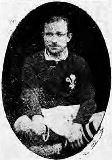
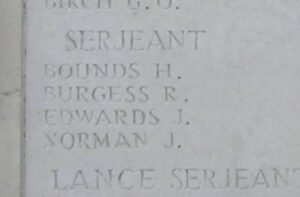
John Robinson Edwards, Private, 23080, Royal Welsh Fusiliers. John was born at Hubberston in 1885, the son of Martha Edwards. The family later resided at 42, Milford Road, Haverfordwest. John enlisted at Haverfordwest into the 9th Battalion, Royal Welsh Fusiliers. The Battalion was attached to 58 Brigade, 19th (Western) Division. The Division assembled around Bulford during September 1914. Divisional training was completed near Tidworth, from March 1915, and the Division crossed to France during July 1915, and moved to positions near Loos. The Division fought during the opening attack of the Battle of Loos, which is where John was killed in action, on 25 September 1915, aged 30. He has no known grave, and is commemorated on the Loos Memorial, France.
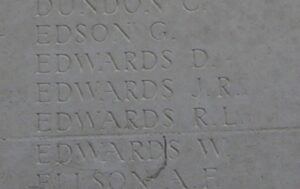
William Grant, Stoker, T/2854, Royal Naval Reserve. William was born at Haverfordwest on 15 February 1885, the son of James and Mary Grant, of 56, Priory Lane, Quarry Street, Haverfordwest. He served in the Royal Navy as a Stoker aboard HMS Teutonic, an Armed Merchant Cruiser, used to patrol the North Sea during the war. William was accidentally killed on 30 December 1917, aged 32. He is buried in St. Thomas A Beckett Churchyard, Haverfordwest.
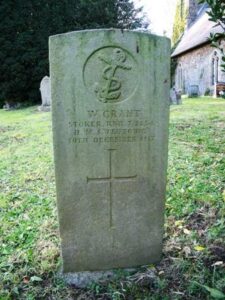
Philip Griffiths, Private, 200115, Welsh Regiment. Philip was born at Haverfordwest and enlisted there the 1/4th Battalion, Welsh Regiment, which was the local Territorial Battalion, attached to 159 Brigade, 53rd (Welsh) Division. The Division landed at Cape Helles, Gallipoli, on 9 August 1915, and was immediately thrown into action, spending the next few days in isolated pockets, fighting against a Turkish counter-attack during the Battle of Sari Bair, and then at the Attack on Scimitar Hill. The Division remained here throughout the coming months, and suffered severe losses in manpower strength during the great November 1915 blizzard on Gallipoli, when its total strength was reduced to less than that of a full-strength Brigade. On 11 December 1915 the Division was evacuated to Mudros, and by 23 December 1915 were moved to Egypt. They remained on the Suez Canal Defences for the next twelve months, where it took part in operations against the Sultan of Darfur, and in March 1917 took part in the advance into Palestine, fighting at the Battles of Gaza, and successfully capturing Jerusalem. Philip was killed during the First Battle of Gaza, on 26 March 1917. He has no known grave and is commemorated on the Jerusalem Memorial, Israel.
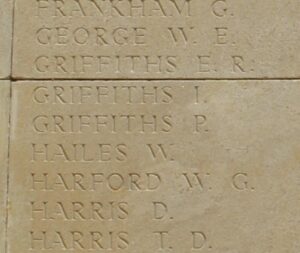
William Hooper, Private, 29137, Welsh Regiment. William was the son of George and Martha Hooper, of 20, Albert Street, Haverfordwest, and the husband of Mary Jane Hooper, of 60, Tirdu Road, Morriston, Swansea. He enlisted at Swansea into the 14th (Swansea Pals) Battalion, the Welsh Regiment, which was attached to 114 Brigade, 38th (Welsh) Division. The Division had landed in France during December 1915 and had spent their first winter in the trenches near Armentieres. In June they marched south to the Somme, where they were tasked with the capture of Mametz Wood. The attack on the wood began on 7 July 1916, but met with fierce resistance, and it wasn’t until 10 July that a fresh assault was launched, with the Swansea Pals in the heart of the fighting. William was killed in action at Mametz Wood on 12 July, 1916, aged 34. He has no known grave, and is commemorated on the Thiepval Memorial, France.
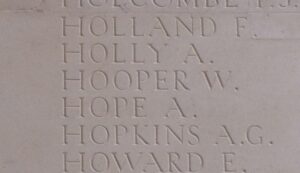
Gilbert George James, Private, 42577, Lincolnshire Regiment. Gilbert was born at Uzmaston in 1898, the son of Matthew and Martha James. He enlisted at Haverfordwest into the Liverpool Regiment, with the Regimental Number 64124. He later transferred into the 10th Battalion, Lincolnshire Regiment, which was attached to 197 Brigade, 66th (2nd East Lancs) Division. The Division concentrated on the Western Front by 16 March 1917 and moved to the Flanders Coast. At the end of September 1917 they moved to Ypres, and took part in the Battle of Poelcapelle. They then moved south to the Somme, and on 21 March 1918 were hit by the German Spring Offensive at the Battle of St Quentin, and moving back west fought at the Actions at the Somme Crossings, and the Battle of Rosieres. Gilbert was taken Prisoner by the Germans on 22 March 1918 during the ensuing mayhem, and he died of captivity on 29 August 1918, aged 19. For some reason Gilbert is commemorated on ‘Special P.O.W. Memorials’ at two cemeteries, at Valenciennes (St. Roch) Communal Cemetery, and at Le Quesnoy Communal Cemetery Extension, France.
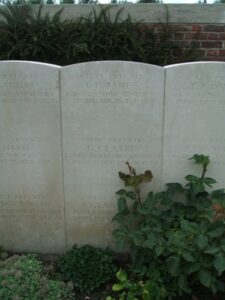
John Elliott James, Private, 31589, South Wales Borderers. John was born in 1899, the son of Thomas and Emily James, of Merlins Hill, Haverfordwest. He enlisted there into the 6th Battalion, South Wales Borderers, which was attached to the 25th Division as Pioneers. The Division landed in France on 26 September 1915, and was posted to the Vimy area, where they defended Vimy Ridge against a German attack in May 1916. They then moved to the Warloy area and attacked on the 3rd July near Thiepval. They fought throughout the Battle of the Somme, and then moved to Ploegsteert, where they held the line for the months leading up the Battle of Messines in June 1917. After fighting at Messines, the Division moved north, and fought at Pilckem, before moving south again, where they took up positions around Bullecourt in reserve. Here the Division was used to reinforce the badly depleted British units that were hit in the area by the German Spring Offensive. John was wounded here, and died of wounds on 28 March 1918, aged 19. He is buried in St. Hilaire Cemetery, Frevent, France.
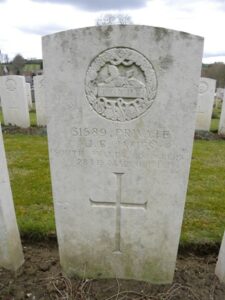
William Thomas John, Private, 54265, Welsh Regiment. William was the son of Thomas and Hester John, of 56, Portfield, Haverfordwest. He enlisted at Haverfordwest into the army, and was posted to the 9th Battalion, Welsh Regiment, which was attached to 58 Brigade, 19th (Western) Division. The Division assembled around Bulford during September 1914. Divisional training was completed near Tidworth, from March 1915, and the Division crossed to France during July 1915, and moved to positions near Loos. The Division fought during the opening attack of the Battle of Loos, and then moved to the Somme, where they took part in the second wave of the attack on Ovillers-La Boisselle on the 1st July, capturing the village at heavy cost, and fought through the Somme Battles of Pozières and the Ancre in 1916. They then moved North to Ypres, taking part in the Battle of Messines, and then moved north to Ypres itself, where it fought on the Menin Road. William was killed in action here on 20 September 1917, aged only 19. He has no known grave, and so is commemorated on the Tyne Cot Memorial, Belgium. He is also commemorated on a stained glass window inside Llandeloy Church.
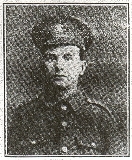
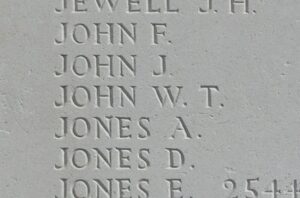
Charles Thomas Jones, Private, 34722, South Wales Borderers. Charles was born in Haverfordwest, and enlisted at Bristol into the 6th Battalion, South Wales Borderers. The battalion was attached to the 25th Division as Pioneers, and landed in France on 26 September 1915, moving to the Vimy area, where they defended Vimy Ridge against a German attack in May 1916. They then moved to the Somme area and attacked on 3 July 1916 near Thiepval. They fought throughout the Battle of the Somme, and then moved to Ploegsteert, where they held the line for the months leading up the Battle of Messines in June 1917. After fighting at Messines, the Division moved north, and fought at Pilckem, before moving south again, where they took up positions around Bullecourt in reserve. Here the Division was used to reinforce the badly depleted British units that were hit in the area by the German Spring Offensive. They moved north to Flanders on the night of 30 March 1918, where they took up positions at Ploegsteert again, where they received reinforcements, and rebuilt. However, on 9 April the Germans launched an offensive on the Lys, and the Division was caught up in the terrible fighting here, taking heavy casualties over the coming weeks. On 9 May the Division moved to Fismes, 20 miles SE of Soissons in the Champagne, to give it a chance to rest and rebuild again. However, on 26 May they took up positions south of the Aisne, to guard against a predicted German Offensive, which hit them the following day, virtually wiping out the division. By 9 June the Division returned to England to rebuild, and returned to the front in September 1918, moving at first to St Riquier near Abbeville. Late in the month, it entrained for Fourth Army, coming under XIII Corps which was by now involved in the great offensive across Picardy, at Cambrai, the Selle, and Sambre. Charles died during the last week of the war, on 5 November 1918. He is buried in Pont-De-Nieppe Communal Cemetery, France.
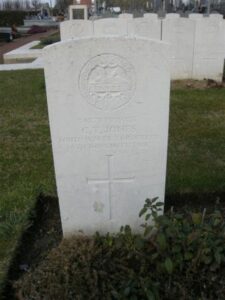
George Frederick Jones, Private, 1140, Welsh Guards. George was the eldest son of Henry and Mary Jane Jones, of Haverfordwest. He enlisted at Llanelli into the 1st Battalion, Welsh Guards. The Regiment was raised by Royal Warrant of 26 February 1915, at White City, before landing at Le Havre on 18 August 1915, becoming attached to 3rd Guards Brigade, Guards Division. The Division saw its first major action during the Battle of Loos on 25 September 1915, remaining in the area during the coming months, where they also fought in the subsequent Action of Hohenzollern Redoubt. After a brief rest period, the Division moved for Ypres for a short spell in what was, at that time, a quiet sector. George was killed in action at Ypres on 29 April 1916, aged 23. He is buried in Potijze Burial Ground Cemetery, Belgium.
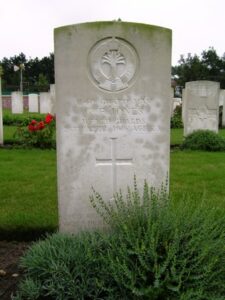
Thomas Evan Jones, Sergeant, 200005, Welsh Regiment. Thomas was born in 1886, the son of James and Ellen Jones, of New Street, Haverfordwest. He was a coach builder prior to the war, and resided with his wife Kate Jones and their children at 82, Dew Street, Haverfordwest. Thomas served with the 1/4th Battalion, Welsh Regiment. The Battalion had served at Gallipoli during 1915 attached to 159 Brigade, 53rd (Welsh) Division, and by 23 December 1915 were moved to Egypt. They remained on the Suez Canal Defences for the next twelve months, and in early 1917 moved into Palestine, where they remained for the duration of the war, fighting at the Battles of Gaza, and successfully capturing Jerusalem. Thomas was killed in action during the First Battle of Gaza, on 26 March 1917, aged 30. He has no known grave, and is commemorated on the Jerusalem Memorial, Israel.
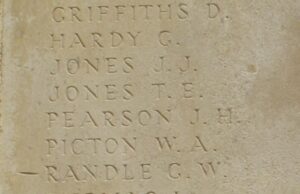
Ivor Lewis Phillips, Private, 728, Welsh Regiment. Ivor was born in 1899, the son of Joseph and Amelia Phillips, of 13, Cartlett, Haverfordwest. He enlisted at Carmarthen into the 1/4th Battalion, Welsh Regiment, which was formed there on 4 August 1914, as part of South Wales Brigade, Army Troops. In November 1914 they moved to Tunbridge Wells, and then in February 1915 to Scotland on Forth and Tay Defences. On 17 April 1915 they joined 159 Brigade, 53rd Division at Bedford. Ivor took ill about this time, and was hospitalised. He died on 12 May 1915, aged just 16, and was buried in St. Thomas A’Beckett Churchyard, Haverfordwest.
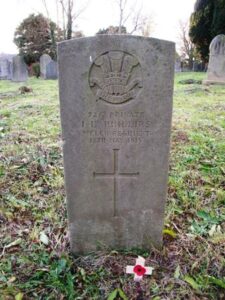
James Richards, Private, 41052, Hampshire Regiment. James was born in Haverfordwest on 6 July 1895. Sometime between 1915 and 1916, he married a Laugharne woman, Mary Ann Brown, daughter of David and Elizabeth Brown of Frog Street, Laugharne. James enlisted into the army and was posted to the 2/5th Battalion, the Hampshire Regiment. The 2/5th Battalion, a territorial Battalion, formed at Salisbury Plain in September 1914, becoming part of 2/1st Hampshire Brigade, 2nd Wessex Division. On 13 December 1914 they sailed for India, and on 29 April 1917 left for Egypt, arriving at Ismailia on 5 April 1917, where they became attached to 232 Brigade, 75th Division. The 75th Division Formed in Egypt in March and April 1917, and under special instruction included units of the Indian Army. The assembly of the various units required was slow and the Division did not take final shape until August 1918. Artillery was difficult to provide, and the Division included a brigade supplied by South Africa. The Division served in Egypt and Palestine, taking part in the Third Battle of Gaza during October/November 1917, then the Capture of Junction Station, the Battle of Nabi Samweill and the capture of Jerusalem. At some stage around the time of the Battle of Nabi Samweill, James fell ill, and was hospitalised at Alexandria. He passed away on 9 December 1917, aged 22. His bereaved widow, Mary Ann had already suffered the heartbreak of the death of their twenty one month old daughter Florence Martha Richards who had passed away during September 1917 without James ever having the chance to see his daughter. James was buried in Alexandria (Hadra) War Memorial Cemetery. He was just 22 years old. Mary remarried after the war, and was my Great Grandmother. She died at home in Spring Gardens, Laugharne in 1976.
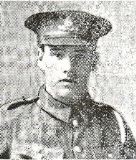
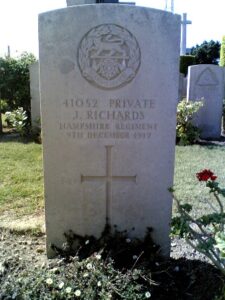
James Bowen Richards, Private, 53642, Cheshire Regiment. James was born in 1899, the son of John and Margaret Richards, of 21, Portfield, Haverfordwest. He enlisted at Haverfordwest into the Army on 14 September 1916, and was mobilised on 20 September 1917. On 8 April 1918 James was posted to the 1st Battalion, Cheshire Regiment, which was attached to 15 Brigade, 5th Division. The Division had fought on the Western Front since the beginning of the war, and had seen action in almost every major offensive of the war. On 2 August 1918, James was wounded, after being shot in the chest. He was taken prisoner by the Germans, and died of his wounds on 1 December 1918, aged 19. James is buried in Germany at Cologne Southern Cemetery.
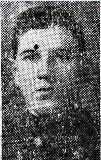
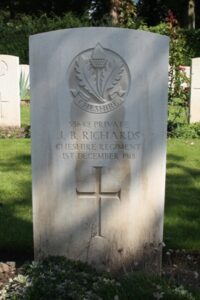
Charles Allen Rogers, Private, 57225, Welsh Regiment. Charles was born in 1887, the son of Henry James Rogers and Sarah Ann Rogers (nee Davies), of Mariner’s Square, Haverfordwest. He married Rose Harries in 1910, and the couple resided at 18, Bush Row, Haverfordwest. Charles enlisted at Swansea into the 7th (Cyclist) Battalion, Welsh Regiment on 18 March 1915, and on 26 July 1916 landed in France, where he was posted to the 13th Battalion, Welsh Regiment which was attached to 114 Brigade, 38th (Welsh) Division. The Division had landed in France during December 1915 and had spent their first winter in the trenches near Armentieres. In June they marched south to the Somme, and famously captured Mametz Wood. Charles was part of a draft of reinforcements which helped rebuild the strength of the decimated battalion after it had been pulled from the Somme, and moved to Ypres to rebuild. Here they fought at the Battle of Pilckem Ridge, and the Battle of Langemarck, which is where Charles was killed in action on 21 August 1917, aged 30. He has no known grave, and so is commemorated on the Tyne Cot Memorial, Belgium.
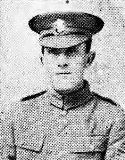
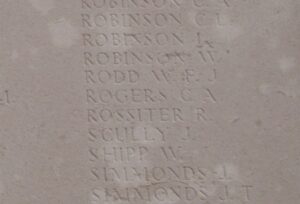
Thomas Henry Saies, Private, 335, Welsh Regiment. Thomas was the son of John Arthur Saies and Jane Elizabeth Saies, of 109, Cowley Cottages, Portfield, Haverfordwest. He had enlisted at Haverfordwest into the Welsh Regiment at the outbreak of war, and was posted to the 1/4th Battalion, which had been formed at Carmarthen during August, 1914. The Battalion became attached to 159 Brigade, 53rd (Welsh) Division. The 53rd Division moved to the Mediterranean, sailing from Devonport in July, 1915 arriving at Mudros by the 5th August, 1915. From here they moved to Gallipoli, landing on 9 August. Here they immediately faced the chaos that was to lead to the ultimate failure of the campaign, and spent the next few days in isolated pockets, fighting against a Turkish counter-attack. Thomas was wounded during his first days on Gallipoli, and was evacuated via Hospital Ship to the Base Hospital at Lemnos. Sadly, Thomas died of wounds there on 1 September 1915, aged 19. He was buried in Portianos Military Cemetery, Lemnos, Greece.
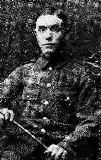
James Dudley Sinnett, Private, 94670, Royal Army Medical Corps. James was the son of Councillor Richard and Martha Sinnett, of 25, Portland Terrace, Haverfordwest. He was working as a nurse at Marylebone, London prior to the war, and enlisted there on 27 January 1916 into the Royal Army Medical Corps. He worked at the 2nd Northern General Hospital at Leeds, before being posted to the 35th Company, RAMC. James died of pneumonia at Queen Alexandra’s Military Hospital, Millbank on 13 January 1918, aged 27. He was buried in St. Martin Cemetery, Haverfordwest.
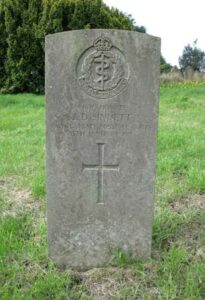
Hubert William Thomas, Private, 44378, Kings Liverpool Regiment. Hubert was born at Martletwy in 1880, the son of John and Elizabeth Thomas. He resided at Haverfordwest prior to the war, and enlisted there into the Welsh Regiment, with the Regimental Number 40477. Hubert then transferred into the Labour Corps, and his Number changed to 130033. This was probably as a result of wounds, which forced him to be medically downgraded. Hubert then transferred to a Labour Company of the King’s Liverpool Regiment, and remained in Britain on Home Service. He died at Chester on 20 May 1917, aged 37 and is buried in St. Thomas A Beckett Churchyard, Haverfordwest.
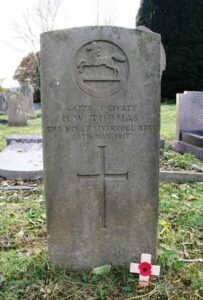
John Arloe Edward Thomas, Leading Carpenter, 345555, Royal Navy. John was the son of Charles and Martha Thomas, and was born on 27 August 1880 at Horsepool Farm, Laugharne. When Charles retired from farming at Horsepool, the family moved to number 17, St. Thomas’ Green, Haverfordwest. John would have already been in the Royal Navy at the outbreak of the Great War. He was a Leading Carpenter, with the service number 345555, aboard HMS Hawke. Here he served with another local man, Engineering Lieutenant Commander Thomas Morgan David, of Laugharne. HMS Hawke was an Edgar Class Cruiser, which saw service in the war as a converted depot ship for destroyers and submarines. She was torpedoed and sank by the German submarine U-9 on 15 October 1914, with the loss of 500 men. Only 70 survived. John was lost in the sinking of the Hawke, along with his fellow Laugharne man Thomas Morgan David. He was 34 years old, and is commemorated on the Chatham Naval Memorial, Kent.
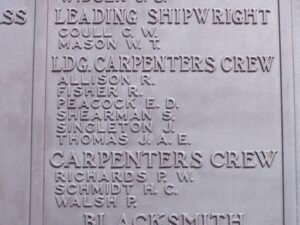
Henry Percival Watkins, Lance Corporal, 5948, Royal Warwickshire Regiment. Henry was the son of Benjamin Thomas Watkins and Elizabeth Louisa Watkins, of 190, Robert Street, Milford Haven. He had originally enlisted at Haverfordwest into the 4th Welsh, with the service number 354, but was posted to the 2/7th Battalion, Royal Warwickshire Regiment along with a large batch of other men of the 4th Welsh, and the new battalion was attached to 182 Brigade, 61st (2nd South Midland) Division. The Division landed in France on 21 May 1916, and moved to the Flanders sector, near the village of Fromelles, where they took over the line from the 38th (Welsh) Division. Here the battalion took part in a combined attack with the 4th Australian Division, as a diversion to the main attack on the Somme, but it was a slaughter, with thousands of lives lost needlessly. The 2/7th Warwicks had reached their objective of the German front line trench, but immediately found that they were alone, and surrounded by Germans were annihilated. Henry was 24 years old when he was killed on 19 July 1916. Like many of the other men killed during the battle he has no known grave, and is commemorated on the Loos Memorial, France.
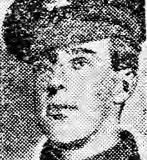
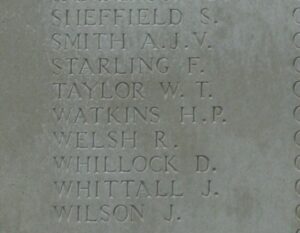
Joseph Gilbert Webb, MC, Lieutenant, Royal Welsh Fusiliers. Joseph was from Burton, and was the Husband of Elizabeth Webb, of Bulmer House, Haverfordwest. He had been commissioned into the Royal Welsh Fusiliers, and served with the 14th Battalion, attached to 113 Brigade, 38th (Welsh) Division. The Division had landed in France during December 1915 and had spent their first winter in the trenches near Armentieres. In June they marched south to the Somme, where they famously captured Mametz Wood. The Division suffered terrible casualties at Mametz, and were taken out of the line, and moved to Ypres to rebuild. Here they fought at the Battle of Pilckem Ridge, and the Battle of Langemarck. They then moved to Armentieres, where they remained from September 1917 until March, 1918 when the German Spring Offensive was launched. The British had been over-run on the Somme, and so in April the Division was moved south, taking up positions North of Albert, from where they weathered the storm of the coming months. Joseph was wounded at some stage in early 1918, and evacuated to a Hospital in Britain for treatment, but sadly died of wounds on 9 May 1918. He is buried in St. Thomas A Beckett Churchyard, Haverfordwest. Joseph was the holder of the Military Cross, for gallantry.
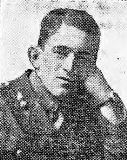
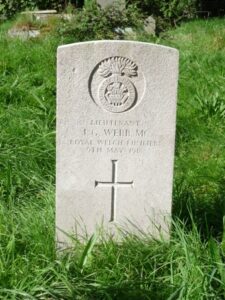
Timothy Whelton, Private, 24410, Welsh Regiment. Timothy was the son of Bartholomew and Mary Whelton of 109, Albert Row, Haverfordwest, and the husband of Mary Jane Whelton, of 43, Heol y Varteg Road, Ystalyfera, Swansea. He enlisted at Cwmgors into the 17th Battalion, Welsh Regiment, which was attached to 119 Brigade, 40th (Bantam) Division. This Division was formed between September and December 1915, and moved to France between 1 and 9 June 1916, moving to the front near Loos. Late in 1916 they moved south to the Somme, and fought at the Battle of the Ancre, and remained in the area over the winter. In March, 1917 the Germans withdrew to their shortened line, called the Hindenburg Line, and the 40th Division was one of the Divisions that followed the withdrawal. Later in the year they took part in the Battle of Cambrai, playing an important role in the attack on Bourlon Wood. Timothy was killed during the Battle of Cambrai, on 25 November 1917, aged 29. He is commemorated on the Cambrai Memorial, Louverval, France.
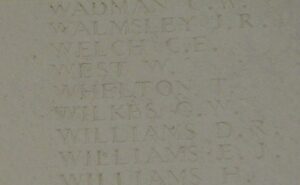
John Williams, Private, 228269, Monmouthshire Regiment. John was the son of Thomas and Martha Jane Williams, of 19, Market Street, Haverfordwest. He was a fish and chip merchant prior to the war, and enlisted at Haverfordwest into the Monmouthshire Regiment in December 1915. John was posted to France on 30 May 1917, and within days was transferred to the 11th Battalion, South Wales Borderers, which was attached to 115 Brigade, 38th (Welsh) Division. He joined the battalion at Boesinghe, where it had held the line since being withdrawn from the Somme in 1916. Here they fought at the Battle of Pilckem Ridge, which is where John was killed on 31 July 1917. He was 22 years old, and is buried in Artillery Wood Cemetery, Belgium.
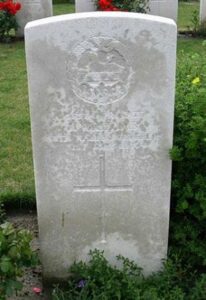
Thomas William Williams, Private, 57188, Royal Fusiliers. Thomas was the son of Martha S. Griffiths, of 1, Commercial Row, Pembroke Dock. He resided at Haverfordwest prior to the war, and enlisted into the 11th Battalion, Royal Fusiliers, which was attached to 54 Brigade, 18th (Eastern) Division. On 25 May 1915 the Division landed in Boulogne, and didn’t see it’s first major action until July 1916 when it took part in the Battle of the Somme. In October they took part in the Battle of the Ancre Heights, and captured Schwaben Redoubt, and helped capture Regina Trench. They then fought at the Battle of the Ancre, and during the subsequent Operations on the Ancre, before spending the winter on the Somme. In March 1917 they followed the German Retreat to the Hindenburg Line, and in May took part in the Third Battle of the Scarpe, which was part of the Arras Offensive. July 1917 saw the Division at Ypres, where they took part in the Battle of Pilckem, where they helped capture Westhoek, and then they fought at the Battle of Langemarck. Thomas was killed here on 10 August 1917, aged 21. He is buried in New Irish Farm Cemetery, Belgium.
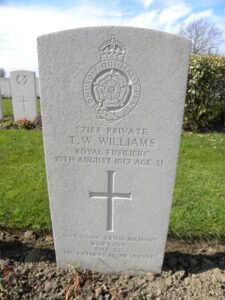
Roll of Honour St. Thomas Parish and Congregation
Located within the Church is a glazed illuminated parchment scroll, which commemorates the 181 men and women of the Parish and Congregation of St. Thomas who served during the Great War. The names are annotated at the side in Latin by: a Red Cross for Mortui (Died); a Red V for Vulnerati (Wounded); and a Red C for Captivi (Prisoner). Four mens names have been added to the bottom left of the memorial, while the names of three women have been added to the bottom right.
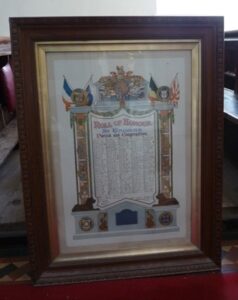
| Adams, W J, Corporal | Davies, W, Corporal | Higgins, H, Nr | Merriman, ?, Private | Rogers, Thorn, Private |
| Allman, G, Private | Davies, Wm, Private | Howells, G, Private | Morgan, W, Sapper | Rogers, Tom, Private |
| Bailleux, F, Private | Devonald, H, Private | Howells, W H, Private | Morgan, J, Sapper | Rosser, G L, |
| Bamkin, W, Rn | Devonald, W J, Private | Hughes, G, Private | Morris, J, Stoker | Saies, T, Private |
| Barber, C, Surgeon Major | Drakeford, F, Private | Jones, Fred, Lance Corporal | Murphy, J, Trooper | Saies, W, Private |
| Beaumont, P, Private | Drakeford, W, Lance Corporal | John, B, Lance Corporal | Murphy, J, Driver | Sinnett, Ed, Lance Corporal |
| Berry, A E, Private | Eaton-Evans, W G, Major | James, G, Corporal | Murphy, M, Driver | Sinnett, F, Private |
| Berry, J E, Private | Edmunds, G, Private | John, F, Private | Nicholas, E, Sergeant | Sinnett, L, Private |
| Biggs, A, Private | Edwards, C, Private | John, W, Private | Nicholas, F C, Private | Sproat, R, |
| Biggs, J, Private | Edwards, F, Private | Jones, A E, Private | Nicholas, J, Private | Squelch, A, Bugler |
| Birch, H, Private | Edwards, H, Private | Jones, Jas, Private | Owen, A, Private | Staley, W, Rn |
| Black, G, Sergeant Major | Edwards, J, Sergeant | Jones, W, Private | Peterson, G, Pioneer | Steers, C, Rn |
| Bowen, T, Private | Edwards, John, Private | Jones, G, Private | Phillips, Bert, Driver | Summers, R H B, Major |
| Bowen, E, Private | Edwards, T, Private | Jones, Jas, Private | Phillips, F, Private | Summons, W T, Artificer Eng |
| Butcher, A S, Sergeant | Edwards, W H, Sapper | Jones, C, Private | Phillips, Ivor, Private | Swales, F, Private |
| Chalinder, H, Lance Corporal | Evans, A, Lance Corporal | Jones, George, Private | Phillips, G F, Lieutenant | Thomas, A, Trooper |
| Cousins, G, Private | Evans, G, Private | Jones, W, Private | Phillips, H, | Thomas, And, Rn |
| Cousins, W, Private | Evans, H, Boy Artificer | Jones, Tom, Private | Phillips, W M, Trooper | Thomas, E, Private |
| Dagwell, F, Rn | Evans, R, Private | Jones, Robert, Sapper | Phillips, W, Private | Thomas, Gilbert, Rn |
| Davies, Arthur, Private | Evans, T, Sapper | James, T, Private | Pollintine, J, Private | Thomas, G, Lance Corporal |
| Davies, B, Private | Footner, W, Po Rn | James, Jack, Sapper | Potter, Theo, Rn | Thomas, G C, 2Nd Lieutenant |
| Davies, C, Driver | Freed, F, Sergeant | Jones, H, Private | Pritchard, F, Private | Thomas, H J P, Captain |
| Davies, D, Private | Gibbs, P, Minesweeper | Jenkins, A, Bugler | Prosser, F P, Cg | Thomas, H, Private |
| Davies, Fred, Lance Corporal | Glass, B, Gunner | King, P, Boy Artificer | Prosser, W H, Rn | Thomas, J A E, Rn |
| Davies, Francis, Corporal | Grant, W, Rn | Laugharne, J, Private | Rees, Edgar, Sergeant Major | Thomas, J, Staff Sergeant |
| Davies, Fred, Private | Griffiths, A, Private | Laugharne, W, Private | Reynolds, Jas, Sapper | Thomas, O C, Gunner |
| Davies, J H, Rn | Griffiths, H, Private | Le Hunte, R, Rn | Reynolds, J, Sapper | Thomas, T R, Sergeant |
| Davies, Jas, Private | Griffiths, H, Gunner | Lewis, Glyn, Corporal | Reynolds, J, Private | Thomas, Walt, Private |
| Davies, J, Private | Griffiths, Jesse, Private | Lewis, J H, Lieutenant | Reynolds, W B, Corporal | Thomas, W, Private |
| Davies, L, Private | Griffiths, J, Sapper | Lewis, P P, Private | Reynolds, W J, Lieutenant | Walton, C, Sergeant |
| Davies, R, Private | Griffiths, Jos, Groom | Lewis, R J, Private | Richards, M, Private | Watkins, J, Lance Corporal |
| Davies, T R, Private | Griffiths, Phil, Lance Corporal | Lewis, Wilfrid, Private | Richards, W, Pioneer | Weeks, L, Corporal |
| Davies, V, Private | Gwyther, H, Sergeant | Lloyd, W G, Trooper | Robbins, A, Private | Whelton, M, Sapper |
| Davies, W R, Lance Corporal | Harries, J, Private | Lucas, P, Gunner | Rogers, C A, Sergeant | Williams, R H, |
| Hart, P, Gunner | Mathias, W J, Sergeant Major | Rogers, F, Corporal | Williams, T, Private | |
| Williams, Tom, Private | ||||
| Williams, T W, Private | Bennett, E M V, Red Cross Nurse | |||
| Williams, W, Private | Parkinson, E C, Red Cross Nurse | |||
| Lermani, J, Sapper | Trew, G, Red Cross Nurse | |||